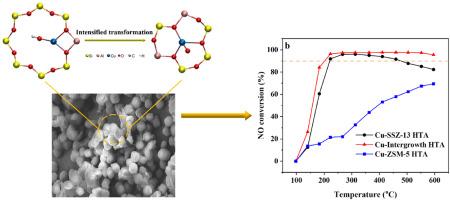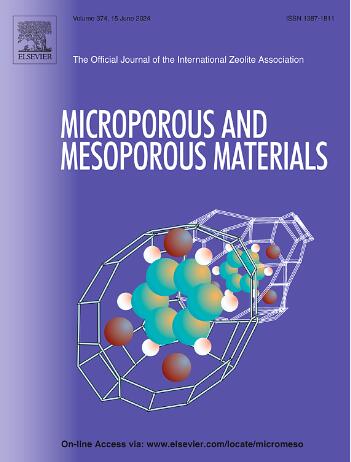在 SSZ-13/ZSM-5 互生沸石上用 NH3 选择性催化还原 (SCR) 氧化氮
IF 4.8
3区 材料科学
Q1 CHEMISTRY, APPLIED
引用次数: 0
摘要
采用双模板法合成了一种结合了 SSZ-13 和 ZSM-5 结构的互生沸石,用于氮氧化物与 NH3 的选择性催化还原(SCR)。通过详细的表征证实了这种互生结构。与纯相沸石相比,经过水热老化(750 °C、10% H2O、16 小时)后,在 220 °C以上的温度下,间生沸石的氮氧化物转化率提高了 14%。综合表征显示,在水热老化过程中,互生沸石促进了水热稳定性较低的铜物种(ZCuOH,位于 8 MR 处)向水热稳定性较高的铜物种(Z2Cu,位于 6 MR 处)的转化。此外,由于生长间沸石的结构完整性保存完好,铜浸出受到阻碍,结晶度仅略有下降(1.6%)。这些研究结果表明,互生沸石是在苛刻的热液条件下(如火力发电和钢铁制造中)减少固定污染源氮氧化物排放的理想候选材料。本文章由计算机程序翻译,如有差异,请以英文原文为准。

Selective catalytic reduction (SCR) of NOx with NH3 over the SSZ-13/ZSM-5 intergrowth zeolite
An intergrowth zeolite combining the SSZ-13 and ZSM-5 structure was synthesized using a dual-template method for application in selective catalytic reduction (SCR) of NOx with NH3. The intergrown structure was confirmed through detailed characterization. Compared to pure-phase zeolites, the intergrowth exhibited up to a 14 % enhancement in NO conversion at temperatures above 220 °C after hydrothermal aging (at 750 °C with 10 % H2O for 16 h). Comprehensive characterization revealed that intergrowth zeolite promoted the transformation of hydrothermally less stable Cu species (ZCuOH, located at 8 MR) to hydrothermally more stable Cu species (Z2Cu, located at 6 MR) during hydrothermal ageing. Additionally, copper leaching is hindered due to the well-preserved structural integrity of the intergrowth zeolite, with only a slight decrease in crystallinity (∼1.6 %). These findings suggest that intergrowth zeolites are promising candidates for mitigating NOx emissions in stationary sources under harsh hydrothermal conditions, such as that found in thermal power generation and steel manufacturing.
求助全文
通过发布文献求助,成功后即可免费获取论文全文。
去求助
来源期刊

Microporous and Mesoporous Materials
化学-材料科学:综合
CiteScore
10.70
自引率
5.80%
发文量
649
审稿时长
26 days
期刊介绍:
Microporous and Mesoporous Materials covers novel and significant aspects of porous solids classified as either microporous (pore size up to 2 nm) or mesoporous (pore size 2 to 50 nm). The porosity should have a specific impact on the material properties or application. Typical examples are zeolites and zeolite-like materials, pillared materials, clathrasils and clathrates, carbon molecular sieves, ordered mesoporous materials, organic/inorganic porous hybrid materials, or porous metal oxides. Both natural and synthetic porous materials are within the scope of the journal.
Topics which are particularly of interest include:
All aspects of natural microporous and mesoporous solids
The synthesis of crystalline or amorphous porous materials
The physico-chemical characterization of microporous and mesoporous solids, especially spectroscopic and microscopic
The modification of microporous and mesoporous solids, for example by ion exchange or solid-state reactions
All topics related to diffusion of mobile species in the pores of microporous and mesoporous materials
Adsorption (and other separation techniques) using microporous or mesoporous adsorbents
Catalysis by microporous and mesoporous materials
Host/guest interactions
Theoretical chemistry and modelling of host/guest interactions
All topics related to the application of microporous and mesoporous materials in industrial catalysis, separation technology, environmental protection, electrochemistry, membranes, sensors, optical devices, etc.
 求助内容:
求助内容: 应助结果提醒方式:
应助结果提醒方式:


